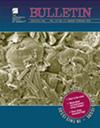美国南加州莫哈韦地区中新世鸽泉组哺乳动物区系变化与构造史的关系
IF 3.9
1区 地球科学
Q1 GEOSCIENCES, MULTIDISCIPLINARY
引用次数: 0
摘要
构造作用通过局部和区域地形起伏变化驱动盆地演化,并对哺乳动物丰富度和分布产生长期影响。哺乳动物通过进化、地理范围的变化以及改变它们的群落组成来应对由此产生的景观和气候变化。本文以美国南加州中新世鸽泉组(12.5 ~ 8.5 Ma)为研究对象,评价了构造时期与化石哺乳动物多样化史的关系。该地层包含丰富的哺乳动物和其他脊椎动物的化石记录,以及盆地伸展、旋转和平移构造时期的构造和沉积学证据。我们使用了几种方法将化石记录与鸽子泉组的构造历史进行比较。我们更新了地层的地质年代学,以结合当前的辐射测年标准,并测量了额外的地层剖面,以将大型哺乳动物(1公斤)化石位置的时间分辨率提高到200千光年(或更短)的间隔。观测到的物种丰富度随时间的变化趋势与地点和标本数量相同,表明丰富度反映了采样强度。使用80%置信区间的地层范围估计值进行人均多样化分析,并采用似然方法分析动物组成从一个时间间隔到下一个时间间隔的变化。虽然边缘效应在研究间隔的开始和结束时影响时间箱,但我们发现多样化率和动物组成的变化并不仅仅与保存有关。一些罕见的物种出现在10.5 Ma,尽管保存率不同,但它们一直存在于地层顶部。12.1 Ma和10.5 Ma的区系组成变化与保存率升高无关,这表明一些区系变化主要不是由采样努力驱动的。地层下部的特点是起生率高,停留时间长。上半部分的人均灭绝率较高,从10.5 Ma开始随着盆地的旋转和平动而增加。动物组成的最大变化与盆地的旋转和平移相吻合,这中断了一个长期的伸展期。构造在哺乳动物的多样性中发挥了关键作用,它决定了化石产量,塑造了它们居住的景观。本文章由计算机程序翻译,如有差异,请以英文原文为准。
Mammalian faunal change of the Miocene Dove Spring Formation, Mojave region, southern California, USA, in relation to tectonic history
Tectonic processes drive the evolution of basins through local and regional changes in topographic relief, which have long-term effects on mammalian richness and distribution. Mammals respond to the resulting changes in landscape and climate through evolution, shifts in geographic range, and by altering their community composition. Here, we evaluate the relationship between tectonic episodes and the diversification history of fossil mammals in the Miocene Dove Spring Formation (12.5−8.5 Ma) of southern California, USA. This formation contains a rich fossil record of mammals and other vertebrates as well as structural and sedimentological evidence for tectonic episodes of basin extension, rotation, and translation. We used several methods to compare the fossil record to the tectonic history of the Dove Spring Formation. We updated the formation’s geochronology to incorporate current radiometric dating standards and measured additional stratigraphic sections to refine the temporal resolution of large mammal (>1 kg) fossil localities to 200-kyr (or shorter) intervals. Observed species richness over time follows the same trend as the number of localities and specimens, suggesting that richness reflects sampling intensity. Estimates of stratigraphic ranges with 80% confidence intervals were used to conduct per capita diversification analysis and a likelihood approach to changes in faunal composition from one time interval to the next. While edge effects influence time bins at the beginning and end of the study interval, we found changes in diversification rates and faunal composition that are not solely linked to preservation. Several rare species appear at 10.5 Ma and persist through the top of the formation despite variable preservation rates. Changes in faunal composition at 12.1 Ma and 10.5 Ma are not associated with elevated preservation rates, which indicates that some faunal changes are not primarily driven by sampling effort. The lower portion of the formation is characterized by high origination rates and long residence times. The upper portion has high per capita extinction rates that increased in magnitude as basin rotation and translation progressed from 10.5 Ma. The greatest change in faunal composition coincided with basin rotation and translation that interrupted a long-running extensional period. Tectonics played key roles in the diversity of mammals by determining fossil productivity and shaping the landscapes that they inhabited.
求助全文
通过发布文献求助,成功后即可免费获取论文全文。
去求助
来源期刊

Geological Society of America Bulletin
地学-地球科学综合
CiteScore
9.30
自引率
8.20%
发文量
159
审稿时长
4-8 weeks
期刊介绍:
The GSA Bulletin is the Society''s premier scholarly journal, published continuously since 1890. Its first editor was William John (WJ) McGee, who was responsible for establishing much of its original style and format. Fully refereed, each bimonthly issue includes 16-20 papers focusing on the most definitive, timely, and classic-style research in all earth-science disciplines. The Bulletin welcomes most contributions that are data-rich, mature studies of broad interest (i.e., of interest to more than one sub-discipline of earth science) and of lasting, archival quality. These include (but are not limited to) studies related to tectonics, structural geology, geochemistry, geophysics, hydrogeology, marine geology, paleoclimatology, planetary geology, quaternary geology/geomorphology, sedimentary geology, stratigraphy, and volcanology. The journal is committed to further developing both the scope of its content and its international profile so that it publishes the most current earth science research that will be of wide interest to geoscientists.
 求助内容:
求助内容: 应助结果提醒方式:
应助结果提醒方式:


